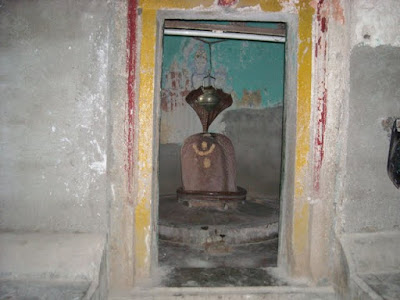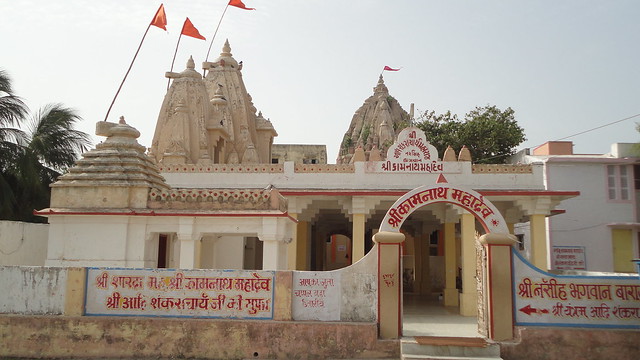Somnath or Pattan Somnath is located in the Prabhas Kshetra near Veraval in Saurashtra, on the western coast of the State of Gujarat. Somnath is situated at a distance of 79 km from Junagadh, 25 km from Chorwad and 5 km from Veraval Beach, on the confluence of the mythological Saraswati, Hiranya and Kapila rivers.Somnath had been destroyed quite a few times by its invaders who were attracted by its treasures and wealth. As per the ancient inscriptions and carvings found in Somnath, it is clear that the place was originally inhabited by Aryans. Somnath was a princely state of Junagadh before Indian Independence. The place received its name from the Somnath temple. Somnath is also known by names like Deo Pattan, Prabhas Pattan or Pattan Somnath. It is believed that the first temple of Somnath was erected much before the beginning of the Common Era. The references to the Temple of Somnath can be found in ancient texts like Rig Veda, Skandpuran, Shreemad Bhagavat Geeta, Shivpuran, etc. Junayad, the Arab governor of Sind, sent his troops to destroy the temple in 725 AD. Nagabhata II of the Pratihara dynasty resurrected the temple in 815 in red sandstone. Mahmud Ghazni raided and destroyed the temple in 1024 AD. King Bhoj of Malwa of the Paramara or Panwar dynasty and the Chalukya King Bhima of Anhilwara rebuilt the temple in the period 1026 – 1042. Kumarpal replaced the wooden structures in the Temple with stone in between 1143-72. Going down the centuries, Sultan Allauddin Khilji, Muzaffar Shah I and Mahmud Begda looted and destroyed the Somnath Temple and the Mughal Emperor Aurangzeb even built a mosque on the site of the temple. Post Independence, the Somnath Temple was reconstructed in the Chalukya style of temple architecture.
How to reach here:
By Air: The closest airport is located at Rajkot and this airport is connected to the city of Mumbai by a daily flight.
By Rail: Verawal Railway Station is an important station in the state and it is well connected to places such as Rajkot, Ahmadabad, Bhopal, Ujjain, Pune, Vadodara, Mumbai, Trivandrum and Jabalpur.
Best time to visit: Throughout the year.
Places you must visit:
Prabhas Patan is a place of pilgrimage or Tirtha, which is also known as Somnath Patan.Situated 7 km away of Verawal, this place of pilgrimage is famous for the most popular Jyotirlinga of Lord Shiva. As per the legends, it is believed that Lord Krishna left a mortal body at the end of Krishna avatar enacting the drama of being killed by hunter Jara.

Gita Mandir, popularly known as Birla Temple, is a marble temple located at the confluence of three holy rivers known as Triveni Tirtha. Dedicated to Lord Krishna, this temple is decorated with the inscriptions that depict the several images of Gita Hymns. This temple is known as Birla Temple because it was constructed by Birla family in 1970.According to the mythology, when Lord Krishna was shot by the hunter Jara, he walked about 4 km from Bhaluka Tirtha to reach the site of this temple. One of the most unique things about this temple is that one can hear the echo of his voice inside the temple. Due to this reason, the Krishna bhajans sung by the devotees always echo in the environment.

The Junagadh Gate, the prime gateway to Somnath, is one of the major attractions of the Verawal region. Built several centuries ago, this triple gate has a rich history.Decorated with intricate carvings, this gate was broken by Mohammed Ghazni. He entered the city of Somnath and destroyed and looted all the temples.

The Panch Pandav Gufa, located near Lalghati in Somnath, is a temple founded by the Late Baba Narayandas in 1949. He dedicated this temple to the five Pandava brothers.Along with the idols of the five Pandava brothers, the idols of Lord Shiva, Lord Rama and Goddess Durga are also enshrined in this temple. A Sanskrit college has been established in its compound.


Bhaluka Tirtha, also known as Bhalka Teerth, is believed to be a site where a hunter named Jara hit Lord Krishna with an arrow. This place is known for its holy tirth (pond), which is located at the confluence of the three holy rivers.Out of the three holy rivers, one is the Hiran River. According to legend, when Lord Krishna was sitting under a banyan tree in meditation, Jara, the hunter, shot him with an arrow as he mistook Lord Krishna for a deer.Presently, a temple is located under the banyan tree on the bank of the pond. This small temple is enshrined with an idol of Lord Krishna. At the tirtha, visitors can also see the pink coloured foot of Lord Krishna as well as an image of the hunter Jara sitting with folded hands.


Kamnath Mahadev Temple is a large temple complex, which was built about 200 years ago by a Mayurdhwaj King. The temple complex also comprises a holy pond called Dudhiyu Talav. Besides, water well called as Gangvo Kuvo and a bathing pool known as Mahadev no Kund, are also located inside the temple complex.As per the legends, water of the pond has healing powers that is believed to have recovered Mayurdhwaj King from leprosy.

Triveni Ghat is a site in Somnath, where three holy rivers namely Kapil, Hiran and Saraswati, converges. Popularly known as Triveni Sangam, this confluence symbolises the human birth, life and death. The water of this confluence is believed to be holy and is believed to relief devotees from all curses and ills that have happened in the whole life.Being mentioned in Puranas and great epics Ramayana and Mahabharata, this ghat is a very popular place in Somnath. On the banks of Triveni Ghat, the famous Gita Mandir and Lakshminarayan temple are located.


Lakshminarayan Temple is one of the most popular temples in Somnath that is located close to Gita Mandir. The temple is dedicated to Lord Lakshminarayan, a manifestation of Lord Vishnu. Placed in sprawling complex, this temple is an example of modern Indian architectural style.Besides the idol of Lord Lakshminarayan, deities of many other Hindu gods and goddesses are also enshrined at the temple. The highlights of the temple are the glossy marbles that are embossed with intricate carvings that depict the Puranic stories.

Sana Caves: The remains of the Buddhist establishment of Sana has nearly 60 caves on the three spurs around the three sides of an elevated plateau which slopes sharply down to the stream of Rupen river on the west. The caves were excavated at different heights of the spurs, mostly approached by rock-cut stairs. Considerable attention was paid towards water harvesting and the supply of water was augmented by excavating the caves with a fairly large number of tanks with small oblong mouths having rock-cut walls on three sides.The caves are marked by an austere simplicity and complete absence of sculptures. There are three chaitya-grihas. All of them are apsidal halls with flat ceilings. Two of them, cave 13 and cave 26 have a long veranda with plain pillars resting on a raised basement and supporting a beam below the flat ceiling, while the third has a deep veranda or porch now completely open in the front. The monasteries provide some significant features. They consist of a pillared veranda usually with one or two cells at the back and very rarely three or four cells. The plan of cave 48 is a different one. There are two halls of unusually large dimension. Around the halls are benches. The cave has a central door and a single cell on the dexture and is fronted by a long veranda with having a recess at either end.The pillars and pilasters of one of the caves are connected by back rests. These caves provide a beautiful scenery all around.


Old Somnath Temple, dedicated to Lord Shiva, is one of the ancient temples Somnath that is located on the shore of Arabian Sea. The temple is enshrined with the sacred Shivling, which is one of the 12 Shiva Jyotirlingas. According to the mythological evidences, this temple was constructed by the moon. The moon dedicated this temple to Lord Shiva, to get reprieved from the curse of Daksha. This temple was first destroyed by Mohammed Ghazni in 1026 AD and after that by several Muslim invaders. The last Muslim to demolish this temple was Mughal Emperor, Aurangzeb in 1706. In 1950, this temple was renovated and now contains a high tower of about 50 m height over the main sanctum.




Parashuram Temple is an ancient temple, which is dedicated to Lord Parashuram one of the incarnations of Lord Vishnu. This temple is situated at the bank of the Triveni Ghat and comprises of two ancient Kunds. The rare temple of Parashuram is located at a landscape. According to the mythology, Lord Parashuram had undergone a long period of penance at the site of this temple. He did penance to come out from the curse of killing the Kshatriya Kings.

Somnath Jyotirlinga Temple is one of the main 12 Shiva temples in India. This temple is enshrined with the Jyotirlinga that is adorned with flowers, silver and gold adornments. Constructed in the Chalukya style, this temple stands about 155 ft tall and stone Kalash that weighs 10 tonnes is placed atop the main shikara. According to the mythology, this temple was built in gold by Moon, but Ravana renovated it with silver. Later, Lord Krishna made this temple in wood and finally Bhima built it in stone. This temple has been destroyed by many foreign invaders, but finally it was renovated and opened for the Somnath devotees in 1995.
Somanadham Someswaram Samastha Gunaparagam |
Gora-Padhaka thavagnim Jyothir-Swaroopam Namamyaham ||
Somanadham Someswaram Samastha Gunaparagam |
Gora-Padhaka thavagnim Jyothir-Swaroopam Namamyaham ||



Suraj Mandir, situated at the north of the Triveni Ghat, is an ancient temple. Popularly known as Sun Temple, this temple was constricted for offering prayers to Sun God. Designed with the images of elephants, lions and other animals and birds, this temple is renowned for its architecture. Standing as the symbols of Hindu culture, this temple was renovated after several attacks by Muslim foreign invaders.


Somnath Temple is famous tourist destination of India and with its history of destruction and reconstruction this place is always becomes site of interest of many people all around the world. Somnath Temple is amongst 12 Jyotirlinga of lord Shankara, that's why many shrines visits this temple every year. I've got one post on Indiahistoricalplaces.com where you'll find all the details about this temple, its historical importance and also about its spiritual values.
ReplyDeleteSomnath Temple is a famous tourist place of Gujarat Nearest Place from Veraval. Lots of tourist visitors visiting Somnath every month and looking for Premium Hotel in Somnath. There are many Hotels in Somnath from Luxury to three stars. Hotel Madhuram provides you exact facilities what you have require.
ReplyDeleteThank you for the informative blog along with beautiful ppictures. Veraval,which was founded in 13th or 14th century by Rao Veravalji Vadher, a Rajput.I would like to add that once a fortified port town of the royal family of Junagadh, there are still many places to visit in Veraval which still bears some remnants of the old Nawabi heritage. Since it enjoyes a long coastline, lined with beaches, it is an ideal tourist destination.
ReplyDelete